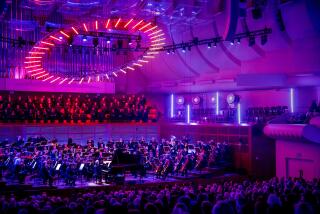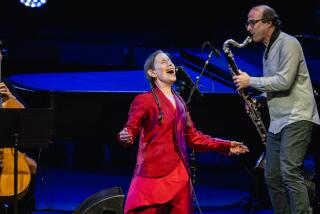Taking a chance on chant
SAN FRANCISCO — IF YOU’VE ever struggled to learn a poem or piece of music by heart, you may have been abashed at the effort required. But consider how much worse you would have felt in medieval Europe.
“Medieval people reserved their awe for memory,” New York University professor Mary Carruthers writes in “The Book of Memory: A Study of Memory in Medieval Culture.” “Their greatest geniuses they describe as people of superior memories, they boast unashamedly of their prowess in that faculty, and they regard it as a mark of superior moral character as well as intellect.”
What’s more, the scarcity of books in the Middle Ages meant that the vast majority of information was exchanged aurally -- and that included musical knowledge. “Learning by ear was the only way music was absorbed, since manuscripts were never used as scores in the sense that we understand,” says Benjamin Bagby, director of the Paris-based early music ensemble Sequentia.
A millennium later, such feats of recall can seem well nigh miraculous, or so I’ve concluded this summer. As a member of the a cappella group the San Francisco Renaissance Voices, I’ve spent more hours than I care to count learning and memorizing the part of the Soul in “Ordo Virtutum” (Order of the Virtues), a musical morality play composed around 1150 by the visionary German abbess, scientist, poet, musician and mystic Hildegard von Bingen (1098-1179).
Hildegard’s composition, which our group is presenting in a series of concerts this month, may have topped the monastic Billboard charts back in the 12th century. But to a classically trained singer weaned on Mozart, Morrissey and Madonna (in other words, music in recognizable keys, with hummable melodies and conventional time signatures), this archaic “opera” concerning the Soul’s journey from temptation to salvation initially seemed to be the opposite of catchy.
The mere prospect of getting the random, meandering sequences of notes and impenetrable Latin lyrics down was daunting enough. But committing the stuff to memory, as our music director, Todd Jolly, had instructed us to do to create a freer interpretation, seemed about as likely as the composer’s strapping on her wimple and putting in an appearance on our opening night.
First there was the issue of language. Although many singers in the U.S. are familiar with pronouncing standard church Latin, the medieval German that Hildegard used followed different rules. It took weeks for us to substitute the “kwids” and “kwods” that had been hard-wired into our brains from singing innumerable masses by Tallis and Byrd for more Germanic-sounding “kvids” and “kvods.”
Remembering to pronounce an S at the start of a word as a Z was similarly tough. And I’m still confused by I. Sometimes it’s pronounced “ih” and other times “ee,” and remembering what sound to make when has been an ongoing struggle.
Then there was the problem of deciphering the musical notation. Scriveners in Hildegard’s monastery wrote down the music and lyrics for “Ordo” shortly after her death. But even though the text features neumes -- basic marks dictating pitch -- and is peppered with unfamiliar flourishes denoting such things as trills and de-emphasized notes, it lacks most conventional modern markings, such as time signatures, note values and even bar lines. In this way, the composer leaves ample room for artistic license -- a scary prospect for musicians who don’t regularly improvise.
Our early rehearsals were a dispiriting struggle to reach a consensus on the ebb and flow of Hildegard’s melodies. We’d all start singing together in perfect monophony, but within a few phrases, the delicate thread of her plainchant would invariably snap. Attempting to memorize phrases as a group caused further chaos. On more than one occasion, we diligently broke chants into bite-sized chunks and worked on them intensively, only to find, by the end of the rehearsal, that we could barely recall a note.
Given the huge advances in printing technology since Hildegard’s day and that most of us don’t feel any strong moral or intellectual obligation to develop our memorization skills, why bother learning “Ordo” by heart at all? I can certainly think of better ways to spend my time than slavishly repeating dozens of chants in the hope that they might stick. Yet once I’d gotten over feeling intimidated by the sheer size of the undertaking, Hildegard’s music and the memorization process started to make sense. Patterns began to emerge, and the music started to feel less like one of Arnold Schoenberg’s 12-tone compositions and more like part of me.
Options for learning
There ARE multiple ways of tackling a work such as “Ordo.” Some of the foremost interpreters of Hildegard’s music, such as Sequentia’s vocalists, learn chants by listening to the director sing a phrase and then repeating it until it’s in their heads. Demanding intensive effort over an extended period, this “call and response” system aims to replicate how medieval nuns would have learned the music.
If only my ensemble had the luxury of working this way. With a mere eight rehearsals to pull our “Ordo” together, we undertook as much of the memorization process as we could individually and relied heavily on our scores. Our memorization techniques included everything from singing small chunks with -- and eventually without -- the music to making and listening to recordings. One cast member even prepared a set of color-coded cue cards, one for every character, inscribed with the text for each chant. I focused on understanding the meaning and flow of the words before singing through a chant. Then it was simply a case of brute repetition. After a while, something would mysteriously click and I would suddenly go from half-remembering one or two phrases to knowing an entire chant by heart.
The music is no longer a chaotic jumble of notes to me, I am happy to report. There are clear motifs, even predictable moments. But remembering how individual phrases hang together continues to be a challenge. Many sections sound so similar that they frequently get transposed in my head.
The most fundamental trick to memorizing “Ordo” -- and indeed any piece of music that seems harmonically or melodically “foreign” -- is to embody it, to create an emotional relationship with it and thereby understand how it works. I don’t mean to sound like a hippie. For many musicians, finding a way to connect to a difficult piece is the first step toward memorizing it.
For some, this might involve understanding at an intellectual level why the composer used a particular motif or chord progression to illustrate a particular phrase. “I’ve found my only success in getting this chant to stick is to know exactly what each word means and try to link the meaning of the text with the melody or texture of the phrases,” says fellow singer Katherine McKee, who plays the role of Humility in our production. “Why does Humility sing ‘Gaudete’ [Rejoice] at the very bottom of her range? If I have an answer to that, I’ll be able to remember the phrase structure.”
Others get inside the music by referring to the composer’s original manuscript. “If you can read Hildegard’s original notation, you know there’s a clear hierarchy to the notes in her chants, something that’s often lost in transcription,” says Cleveland-based singer Charlotte Landrum, who has performed many of Hildegard’s works. “Once you get a sense of this hierarchy, you’re able to make a connection with the music.” For others still, it’s a question of feeling the music vibrate in their bodies or visualizing the notes on the page.
The dramatic method
All OF this would have made perfect sense to Hildegard and her contemporaries. According to Carruthers, emotion played a key role in helping medieval scholars remember important information. Many of them would use as a mnemonic the mood they were in the day they learned a chunk of text. Evoking that mood at a later date would help to bring the text back. Some scholars even went so far as to swoon or work themselves into intense emotional states at the time of memorization to help them trigger their future powers of recall.
It seems as if a little of the ancient scholars’ sensibility has rubbed off on my group, though no one took to swooning in rehearsal. The night I got the first of several Hildegard ear worms -- what psychologist Oliver Sacks has described as the “automatic or compulsive repetition of musical phrases” in the brain -- I didn’t sleep a wink because I was haunted by one of the chants. Now, whenever I want to remember how that segment begins, I picture myself reeling around the next day in an exhausted fog.
Fellow singer Emily Stauffer has reported experiencing visions. “The other night I actually had a dream in which ‘Ordo’ made an appearance,” Emily told me. “In the dream, I had a chant absolutely stuck in my head. I awoke in a state of confusion and decided to give myself the day off from practicing so that my apparently weary brain could have a rest.”
Toward the end of the rehearsal process, our director decided that it would be best to allow scores onstage for the bulk of the chorus sections. But he still charged us with committing all solos and some choruses to memory. “Ideally, we would have the whole piece memorized,” Todd says. But chant, he admits, “is about a hundred times harder to memorize than music that came along later.”
Somehow, we made it through opening night. It was a wing-and-a-prayer kind of experience. Especially prayer. Just two hours before curtain, a couple of the performers were still struggling to remember a tricky, seemingly endless passage at the end of the work. They clung to their scores like nuns to their chastity, afraid of what might happen if they let go. But let go they eventually did, and Hildegard’s little-performed musical mantra rang out anew. The medieval mystic must have been smiling on us: Her music flowed as it had never done in rehearsal. And our memories served us well.
--
San Francisco Renaissance Voices
Where: First Presbyterian Church of Alameda, 2001 Santa Clara Ave., Alameda
When: 7:30 p.m. today
Price: $15; $12, students and seniors
Contact: www.sfrv.org
Also
Where: All Saints’ Episcopal Church, 555 Waverley St., Palo Alto
When: 7:30 p.m. Saturday
Where: St. John’s Presbyterian Church, 2727 College Ave., Berkeley
When: 4 p.m. next Sunday
More to Read
The biggest entertainment stories
Get our big stories about Hollywood, film, television, music, arts, culture and more right in your inbox as soon as they publish.
You may occasionally receive promotional content from the Los Angeles Times.










